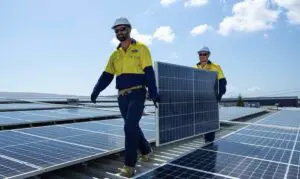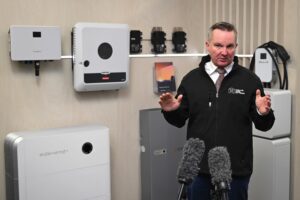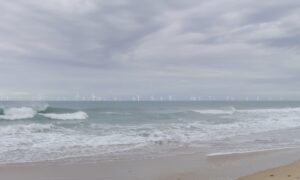Ask any wind and solar developer, investor and financier to cite the biggest problem facing the market today, and they will probably look right past the lack of any serious climate and energy policy from the federal government, or the demonising of renewables by conservatives, and point to the new connection rules that were thrust upon the market a few years ago.
Those rules, and let’s assume they were introduced with the best of intentions, were designed to help address some of the anticipated grid problems that might emerge, particularly in the area of “system strength”, a critical component that relates to the ability of the system to return to stable operating conditions following a disturbance, such as a physical fault on the power system.
To help address the issue, the market rule maker introduced a package of new rules under the label of the “do no harm” principle. It sounded like one of those unimpeachable ideas, but in reality ended up like “natural gas” and “clean coal” – more marketing terms than problem solving. Just how badly it has failed the market, and de-railed the transition to renewables, has now been laid bare.
The absurdity of the “do no harm” rule and and the complete shambles that it has created is highlighted in a recent submission to the market rule maker by Transgrid, the transmission provider in NSW whose job it is to supervise wind and solar farm and other connections in that state.
Developers and investors say it has been one of the main causes of connection and commissioning delays, has completely halted some projects, and required duplicated investment. There is barely a single new project that has not had to declare “force majeure” because of delays, and contractors – stuck with the blame for delayed connections – have suffered huge losses or quit the market altogether, as have some key international developers. And the extra risk has added to the costs of project finance and to the projects themselves.
Transgrid and other network operators agree. Transgrid says one key component of these rules, the “system strength remediation schemes”, which can require a new wind or solar project to install a costly “synchronous condenser” have failed because they are “not well co-ordinated or optimised” and provide “little incentive for competing generators to work together.”
The result is an “uncoordinated” and “ad-hoc” system that results in unnecessary duplication, adding costs, complexity, and actually making grid stability worse rather than better, as we wrote here more than a year ago. “Each time this occurs tens of millions of dollars in unnecessary costs are passed on to consumers,” it says.
In one example it cited, two new generators were effectively forced to double up on the installation of syn-cons, large “spinning machines” that do not burn fuel. “The assets are not sized efficiently, not located appropriately and not operated to support the most efficient ongoing use of the shared network,” Transgrid says.” The unnecessary expense resulting from this one case study run into the tens of millions of dollars.”
Worse, because of the haphazard and reactive nature of the “do no harm” rule, problems sometimes can’t be identified until after they occur, resulting in connection and commissioning delays, costly market intervention and time and money wasted on complex modelling exercises. Absurdly, wind and solar generators required to do complex and costly modelling have to do so without access to the network information. And some developers fear that they are being asked to pay to fix for pre-existing problems.
“The ‘do no harm’ aspects of the framework are increasing the cost of generator connections, including at times through significant delays in connection,” Transgrid notes.
“Determining appropriate system strength remediation schemes can be time consuming and costly. Ordering and commissioning equipment to provide system strength services can significantly delay connection and energisation of new generators.” And, it warns, it’s going to get a lot worse until and unless something is done about it.
Transgrid has proposed a new process that dumps the failed “do no harm” obligation on generators and puts the onus and responsibility on the network operators and the Australian Energy Market Operator to do some central planning and co-ordinate the investment in system strength.

However, this would occur without waiting for a shortfall to be declared by AEMO (This is what has occurred in South Australia where new syn-cons are finally being installed in a co-ordinated basis, but the whole process is considered too slow and has held back the transition to renewables, and resulted in costly interventions and wind and solar constraints).
Transgrid says its proposal means it would be up to the networks to make sure their system was capable of supporting the number of new generators being built. And Transgrid says the savings could be in the hundreds of millions of dollars.
“This would result in quicker, cheaper connection and energisation, which should translate into clear benefits for final customers because the upshot is reduced delivered energy costs,” it says.
“The cost efficiencies here [are] directly passed through to consumers through the lower cost energy purchased by retailers and large customers in the long-term financial arrangements (such as PPAs) that ordinarily underpin the development of new generation projects. It is difficult to measure with precision these benefits, however again it would likely be in the order of hundreds of millions of dollars in the medium term.”
The measures proposed by Transgrid – one of half a dozen new “system services” proposals being considered by the AEMC, the main rule maker – have been broadly welcomed by the industry, particularly the wind, solar and battery developers, but also by some of the more traditional energy companies, with the possible exception of Trevor St Baker’s Delta Electricity, the owner of the Vales Point coal generator.
The Clean Energy Investment Group, which represents many large renewable energy investors, both local and international, said: “The current system strength frameworks are reactive, lengthy, piecemeal and ultimately costly for consumers. TransGrid’s proposal for a proactive and centralised approach to managing system strength is a reform that in our view is urgently needed.”
This was echoed by the Clean Energy Council.
“The CEC strongly supports replacing the ‘do no harm’ framework with a centrally coordinated model for system strength as it places system strength risk with AEMO and the Transmission Network Service Providers (TNSPs) as they are the parties best placed to manage this risk,” it said.
“Such an approach would lead to more efficient system strength planning and management and remove a significant amount of uncertainty for generator investments by potentially reducing connection times and improving the predictability of the connection process and associated connection cost.
“The ability for TNSPs to undertake scale-efficient long-term system strength solutions should also lead to lower costs to consumers.”
Most developers are also supportive of another rule change proposed by Infigen Energy for a market for fast-frequency response, which could encourage more battery storage, which Tesla says would also create “grid forming inverters” that could also help with system strength.
“Indirect benefits can also flow through to the integration of storage if updating ‘do no harm’ provisions can remove current barriers to grid-scale renewable connections, and associated/co-located investments in battery storage assets by project developers,” it says.
Meanwhile, Delta and Vales Point are at odds over Delta’s proposal to create a market for “ramping” services, which most other companies – including coal generators like AGL and CS Energy – dismiss. Most of the criticism is centred at the belief that Delta’s proposal is largely self-serving, favours coal generators over all others, and takes little or no account of what technologies can do.
You can read about it here. See: St Baker’s Delta clashes with solar and battery giants over new system rules
All eyes, in the meantime, are on the AEMC, now under new management, and the decisions it makes on these rule proposals over the next six months. The first of these – its draft ruling on Transgrid’s system strength proposal – is due to be delivered on December 24, probably among a number of important reports released on Xmas Eve, at the start of the holiday break, as appears to be the habit of the energy industry bodies.








